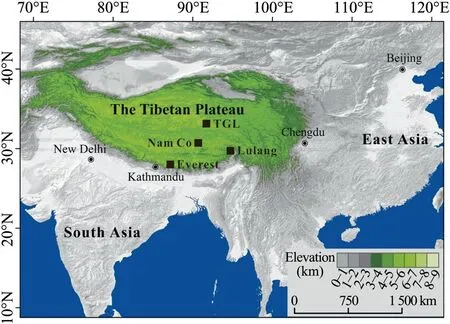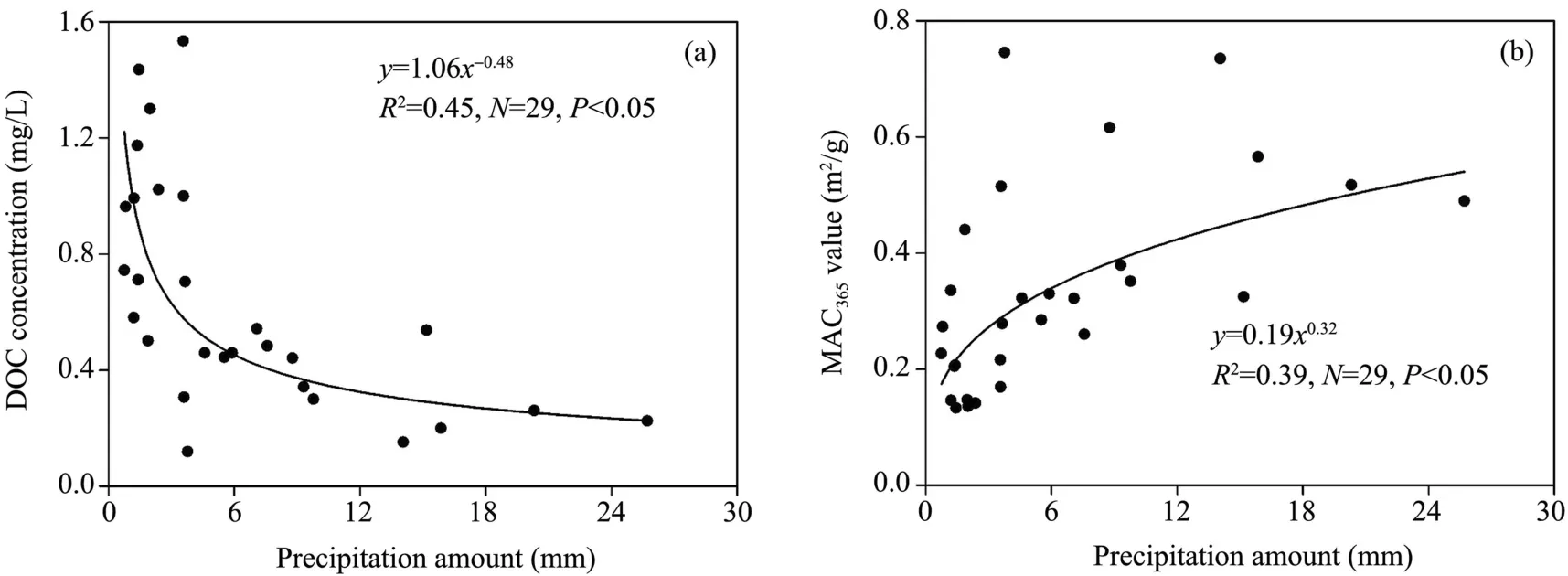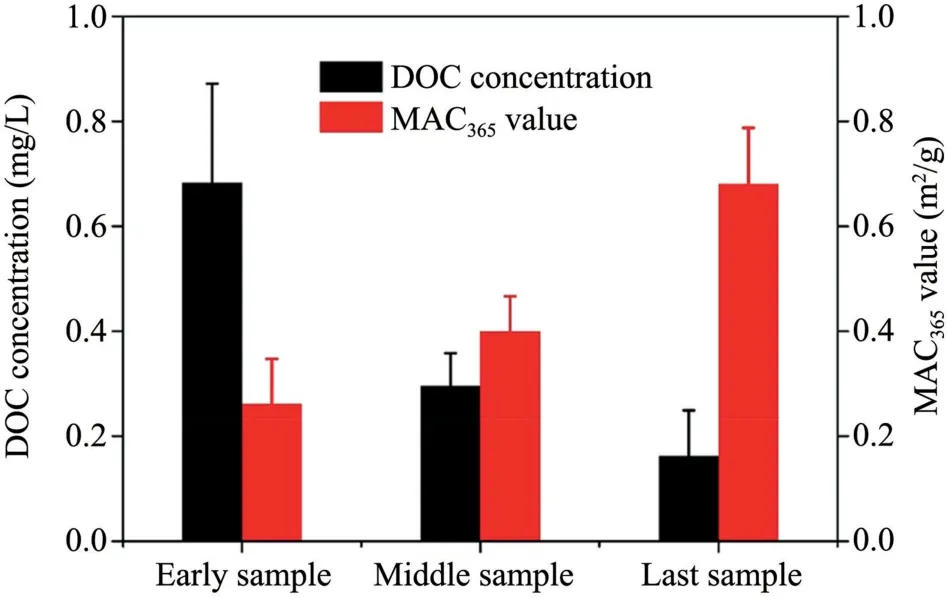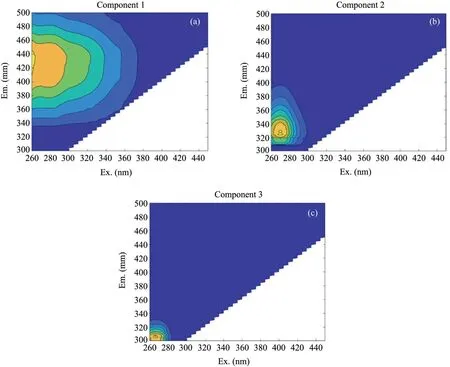Dissolved organic carbon fractionation in wet deposition and its potential impact on radiative forcing in the central Tibetan Plateau
2024-01-02ZhoFuHuChoLiuLiShiChngKngXioFeiLiChoZhngFngpingYnXioBoHePengFeiChen
ZhoFu Hu ,ChoLiu Li ,ShiChng Kng,c,* ,XioFei Li ,Cho Zhng ,Fngping Yn ,XioBo He,PengFei Chen
aState Key Laboratory of Cryospheric Science, Northwest Institute of Eco-environment and Resources, Chinese Academy of Sciences, Lanzhou, Gansu 730000, China
bSchool of Environmental Science and Engineering, Shaanxi University of Science and Technology, Xi'an, Shaanxi 710021, China
cUniversity of Chinese Academy of Sciences, Beijing 100049, China
Keywords:Tibetan Plateau Wet deposition Dissolved organic carbon Light absorption ability Fluorescence characteristics
ABSTRACT As an important component of carbonaceous matters,dissolved organic carbon(DOC)can absorb and scatter the solar radiation at ultraviolet and blue wavelengths.The wet deposition process has great impact on the concentration and light absorption ability of precipitation DOC,affecting the climatic effect caused by DOC in the atmosphere.In this study,light absorption and fluorescence characteristics of precipitation DOC was investigated in the central Tibetan Plateau (TP).The results showed that the mean DOC concentration and mass absorption cross-section measured at 365 nm (MAC365) in Tanggula (TGL) station were 0.59 ± 0.42 mg/L and 0.37 ± 0.19 m2/g,respectively,while both values showed much higher volatilities than those of aerosols.DOC concentrations had significant negative correlation with the precipitation amount,while MAC365 values increase with the precipitation amount in TGL station.Therefore,DOC with high light-absorbing ability was preferred to be retained in the atmosphere during wet deposition.In this study,precipitation DOC contained three fluorescent components (one humic-like component and two tyrosine-like components) mainly from local biomass burning sources.DOC concentration showed a negative relationship with MAC365 value in TGL station.The wet deposition of DOC with low light-absorbing ability can reduce the strong negative radiative forcing caused by secondary organic aerosol due to high proportion of DOC in secondary organic carbon.Similar phenomenon was also found in Nam Co,Lulang and Everest stations of previous study,which may have a potential impact on radiative forcing in the atmosphere of TP.
1.Introduction
The glaciers in the Tibetan Plateau (TP) have shown a trend of accelerating retreat since the 20th century (Yaoet al.,2012).Carbonaceous matters play an important role in solar heating of the atmosphere and snow/ice melting,which was widely investigated in the TP (Ramanathan and Carmichael,2008;Liet al.,2017;Zhanget al.,2017).Although the background environment of TP is relatively clean,the carbonaceous matters are severely affected by long-distance transport from South Asia and East Asia (Kaspariet al.,2011;Chenet al.,2018;Yanget al.,2018)and local emission sources(Liet al.,2016a).Dissolved organic carbon(DOC)accounts for large parts of the organic carbon(OC)in the atmosphere,especially in remote areas (Pioet al.,2007;Liet al.,2016b).
Some components of DOC strongly absorb sunlight at ultraviolet and blue wavelengths.Generally,mass absorption cross-section at 365 nm(MAC365) was used to evaluate the light absorption ability of DOC.A portion of light-absorbing DOC is known as fluorescent DOC,which fluoresces when absorbing ultraviolet light(Hudsonet al.,2007).Due to its simplicity and sensitivity,fluorescence excitation-emission matrix(EEM) spectroscopy has been widely used to study the components and sources of DOC(Wuet al.,2004;Heet al.,2011;Chenet al.,2016;Liet al.,2022).Four fluorescent components of precipitation DOC in the southeast coast of China were identified with EEM,including three humic-like components and one tyrosine-like component (Yanget al.,2019).The fluorescence components of DOC in snow/ice in the TP have also been used to analyze its sources(Fenget al.,2016,2020;Huet al.,2021).For instance,fluorescence components in snowpits of the southern TP were mainly contributed by South Asian sources (Huet al.,2021).However,few studies have explored the fluorescence characteristics of precipitation DOC at the TP.
Previous studies showed that DOC plays an important role in aerosols and snow/ice (Andreae and Gelencs'er,2006;Chakrabartyet al.,2010;Yanet al.,2016).Considering of the black carbon concentration overestimated by OC and carbonates,the fractions of solar energy absorbed by DOC relative to BC rose from 16.0% -44.4% at Nam Co station (Liet al.,2021;Huet al.,2023).Meanwhile,the radiative forcing of snowpit DOC was estimated to be 0.43 W/m at a glacier located in northern TP(Yanet al.,2016),indicating that light-absorbing DOC also caused snow/ice melting.As an important medium between DOC in the atmosphere and snow/ice,precipitation DOC also has an important role in global climate system (Willeyet al.,2000).Therefore,several related studies focused on precipitation DOC.For instance,DOC accounted for over 70%of carbonaceous matters in precipitation of the TP(Yanet al.,2019).As an important input data for global carbon cycle study,the annual DOC wet deposition was investigated in the TP (Liet al.,2016d,2017;Gaoet al.,2021).DOC concentrations were significantly negatively correlated with precipitation values in Jiaozhou Bay of Shandong Province (Xinget al.,2019)and Southeast China(Baoet al.,2018),indicating that DOC concentration in precipitation was controlled by precipitation dilution effect.Light absorption ability of precipitation DOC was much lower than that of aerosols in the TP due to plenty of secondary organic aerosols(SOA) and volatile organic compounds (VOCs) in precipitation DOC (Liet al.,2016d,2017).A previous study has shown that DOC with high MAC365values were preferred to be remained in snowpit,resulting in accelerating melting of glacier(Huet al.,2018).Therefore,fractionation is likely to occur during wet deposition,which will change the light absorption ability of DOC,further affecting the radiative forcing caused by DOC in the snow/ice and atmosphere.Therefore,the study on concentration and light absorption ability of precipitation DOC can increase our understanding on the climate effecting of DOC in aerosols and snow/ice.However,there is not yet relevant study on the DOC fractionation during wet deposition at the TP.
Tanggula(TGL)Mountain is located in the central TP.Due to its high elevation and lack of emission sources,the atmosphere there is clean with sparse aerosols loaded (Kanget al.,2019),providing us a precious site to study the DOC fractionation during wet deposition.Meanwhile,the data from three remote stations of Nam Co,Lulang and Everest (Liet al.,2017c) were also collected.In this study,concentrations,light absorption and fluorescence characteristics of precipitation DOC of TGL station were measured to study the DOC fractionation and its climate effect during wet deposition.Therefore,precipitation samples were collected at TGL station from June to September 2018 and 2019 to investigate (1) the concentrations,MAC365values and fluorescence characteristics of precipitation DOC in this remote area;(2)the variations of DOC concentration and light absorption characteristic of DOC during wet deposition;(3) the potential impact of radiative forcing caused by DOC during wet deposition.
2.Sampling and methods
2.1.Sampling site
TGL station is located in the north slope of TGL Mountains(33°00'36.18"N,91°58'28.49"E,5,050 m a.s.l.;Fig.1),where many relevant studies have been carried out in snowpit and ice core samples(Kanget al.,2015;Matthewet al.,2016;Huet al.,2020).As the boundary between westerly and monsoon regions(Tianet al.,2001),TGL Mountain is located in the source area of the Yangtze River.Total precipitation amount at TGL station was 580 mm during the sampling period.The detailed information of Nam Co,Everest and Lulang stations(Fig.1)can be found in a previous study (Liet al.,2017).The contribution of the precipitation during the sampling period to the annual precipitation at TGL station was 52%.

Fig.1.Location map and sampling sites of TGL,Nam Co,Lulang and Everest stations.
2.2.Sample collection
During the field work,precipitation samples were collected by basins and bags followed the same method of our previous study (Yanet al.,2016;Liet al.,2017;Huet al.,2018).Collected samples were kept frozen in precleaned polycarbonate bottles until analysis.To investigate variations of DOC concentration and MAC365during wet deposition,three sub-samples (early,middle and last samples) were collected in chronological order during heavy precipitation events.Early,middle and last samples were collected during the first half hour,second half hour and remaining time of precipitation events,respectively.The average precipitation for the five heavy precipitation events was 10.56 ± 7.16 mm.Finally,fifteen precipitation sub-samples were collected from five heavy precipitation events.44 precipitation samples(including sub-samples) were collected at TGL station from June to September 2018 and 2019.Three blank samples for DOC were prepared and subjected to the same process as those of the samples.Collection method of precipitation samples and detailed sampling information of Nam Co,Everest and Lulang stations can be found in previous study (Liet al.,2017).
2.3.Laboratory analyses
2.3.1.Concentration measurements for DOC
DOC concentrations were determined using a TOC-5000A analyzer(Shimadzu Corp,Kyoto,Japan)after the collected samples were filtered through a PTFE membrane filter with 0.45-μm pore size (Macherey-Nagel) (Yanet al.,2016).The detection limit of the analyzer and precision,average DOC concentration of the blanks was low of 0.015 mg/L and ±5%,0.02 ± 0.01 mg/L,respectively,demonstrating that contamination during the pre-treatment and analysis processing of these samples was weak.All the reported concentrations in this study were subtracted by those of the blanks.
2.3.2.Light absorption measurements
The precipitation samples were filtered through a PTFE membrane filter with 0.45-μm pore size (Macherey-Nagel) for light absorption measurement (Yanet al.,2016).The light absorption spectra of DOC were measured by a UV-Visible Spectrophotometer (SpectraMax M5,USA) between wavelength of 200 nm to 800 nm with 5 nm precision.Each spectrum was determined relative to that of blank filter treated by the Milli-Q water.The MAC is an important parameter for characterizing the light absorption properties of DOC(Chenget al.,2011;Kirillovaet al.,2014;Liet al.,2016b).Generally,MAC measurement is chosen at 365 nm.This wavelength is justified by the low signal-to-noise ratios(Kirillovaet al.,2014) and the avoidance of interference by nitrate(Chenget al.,2011).The value of MAC is calculated from following equation:
WhereA(absorbance)is derived directly from the spectrophotometer at 365 nm,Lis absorbing path length,andcis DOC concentration.
2.3.3.EEM analysis and parallel factor model
The 3D fluorescence EEM of DOC was measured using a threedimensional fluorescence spectrometer (Aqualog,Horiba Scientific).Excitation wavelengths(Ex)scanned in the range of 200-600 nm in 5 nm steps,and emission wavelengths(Em)were determined between 250 and 600 nm in 1 nm step.Details regarding the measurement method are provided in a previous study (Chenet al.,2020).All the corrected EEM data of the samples were analyzed using a parallel factor (PARAFAC)model with the DOMFlour toolbox in Matlab R2019a(Stedmon and Bro,2008).To determine the optimal number of fluorescence components and test the validity of the PARAFAC model,residual analysis and split-half validation were employed(Zhanget al.,2020).
3.Result and discussion
3.1.DOC concentration
The mean concentration of precipitation DOC in TGL station was 0.59 ± 0.42 mg/L,which was lower than that of other station(Liet al.,2017)and Lhasa(Liet al.,2016d),much lower than that of North China(Panet al.,2010)due to its remote location and high altitude(Table 1).Meanwhile,only sampling in the monsoon period in this study will bring some uncertainties.The variation of DOC concentration in precipitation was very large in this study and previous study(0.33-24.5 mg/L)(Pantelakiet al.,2018),much higher than that of aerosols in the TP(Liet al.,2016b).Previous studies have shown that the precipitation amount had a significant impact on the wet deposition of DOC(Zhanget al.,2014;Baoet al.,2018;Xieet al.,2022).Combined with the meteorological data from the automatic weather station,DOC concentration showed a significant negative correlation with precipitation amount in TGL station(Fig.2),which was also observed in Everest station(Liet al.,2017),Lhasa(Liet al.,2016d)and Southeast China(Baoet al.,2018).Meanwhile,if the interval between the two adjacent precipitations was relatively short,the DOC concentration in previous precipitation was even 5 times higher than that of later precipitation.

Table 1 Comparison of DOC concentrations and MAC at 365 nm (MAC365)in precipitation and snow/ice in this study and previous studies.

Fig.2.Significant negative relationship between DOC concentration and precipitation amount (a);Significant positive relationship between MAC365 values and precipitation amount for precipitation samples (b).
Therefore,in chronological order,sampling for each heavy precipitation event was collected in three times.Similarly,for those precipitation sub-samples,DOC concentrations of a given precipitation event decreased rapidly from the early samples (0.68 ± 0.19 mg/L) to last samples (0.16 ± 0.09 mg/L),indicating that most of the DOC was preferred to be deposited at the early stage of precipitation (Fig.3),which also explained the precipitation dilution effect.Therefore,the DOC concentration with heavy precipitation was relatively small.After the DOC deposited to the glacier,DOC was also easier to be discharge from the snowpit during the melting process,causing the low DOC concentration of snowpit samples(Huet al.,2018,2020).Therefore,the atmosphere and snowpit DOC in the TP can participate in the carbon cycle in time through the wet deposition and melting process(Chaet al.,2020).

Fig.3.Negative variation tendency of DOC concentration and MAC365 value of precipitation samples in TGL station.
3.2.MAC365 value
The mean MAC365value of precipitation DOC was 0.37±0.19 m2/g,which was higher than that of Lulang station(0.25±0.15 m2/g),lowerthan that of Everest station (0.64 ± 0.49 m2/g) (Liet al.,2017) and similar to that of unmelted snowpit in Jiemayangzong glacier(0.41 ± 0.28 m2/g) (Huet al.,2021).Precipitation DOC in Lulang station contained plenty of VOCs with weak light absorption abilities(Zhanget al.,2011),while precipitation DOC in Everest station was significantly affected by DOC in mineral dust (MD) with high absorption abilities(Liet al.,2016b,2017).Similarly,the variation of MAC365value was also very large.MAC365values increased with the precipitation amount (Fig.2).Meanwhile,if the interval between the two adjacent precipitation was relatively short,the MAC365value in previous precipitation was much lower than that of last precipitation,which showed the opposite trend to DOC concentration.The average MAC365value of the last samples(0.68±0.11 m2/g)was around three times higher than that of early samples(0.26±0.09 m2/g),indicating that the DOC with high light absorption ability was likely to be kept in the atmosphere during wet deposition (Fig.3).Similarly,the high light-absorbing DOC was likely to be kept in the snowpit during the melting process (Huet al.,2018),causing the MAC365value of the snowpit samples (2.17 ± 2.13 m2/g) much higher than that of precipitation samples (Liet al.,2017;Niuet al.,2019;Huet al.,2020),even the aerosols (1.18 ± 0.64 m2/g in Everest station) (Liet al.,2016b).Therefore,the mean MAC365value(1.45±1.37 m2/g)of the snowpit in a glacier near TGL Station was much higher than that of precipitation indicating the similar behavior of DOC during wet deposition and snow melting process.Seasonally,the dominant precipitation type in winter was snowfall,in which the DOM contained more high-molecular-weight compounds with higher aromaticity and humification degree (Pantelakiet al.,2018;Xieet al.,2022).With the increase of snowfall proportion in September,the actual MAC365value(0.44 ± 0.21 m2/g) was higher than that of the fitted value probably because VOCs had less contribution to precipitation DOC in September caused by plants death.
3.3.Fluorescence characteristics of DOC in precipitation
Chemical bleaching and photobleaching can effectively decrease light absorption ability of aerosols DOC (Liet al.,2016b).Similarly,photobleaching can effectively remove fluorescent DOC of snowpit samples in the TP (Huet al.,2021) and rainwater samples (Kieberet al.,2007).Because precipitation DOC in July and August contains the contribution of VOCs emitted by plants,the light absorption abilities of precipitation DOC in July and August were weak(Xieet al.,2022),which resulted in some samples having no fluorescence signal.Instead,the precipitation DOC in September showed strong fluorescence signals.Similar changes in fluorescence intensity of DOC were also found in Greece (Pantelakiet al.,2018).In summer,visible fluorescence signals can be detected of DOC in aerosols at southeast TP (Zhanget al.,2020),which can also prove that light absorption ability of precipitation DOC was weak.Similarly,DOC compounds responsible for absorbance may be the same as those responsible for fluorescence in rainwater samples(Kieberet al.,2006).Therefore,the fractionation of fluorescence DOC in wet deposition should be consistent with the fractionation of light-absorbing DOC.In this study,some precipitation samples with strong fluorescence signals were selected for analysis.In this study,three fluorescent components in precipitation DOC were identified with EEM-PARAFAC,including one humic-like component and two tyrosine-like components (Fig.4).Component 3 (C3,tyrosine-like component) was the dominant chromophore with a contribution of 46.1% ± 19.7% to the total fluorescence components,followed by Component 2(C2,tryptophan-like component)(37.3%±14.5%).

Fig.4.Fluorescence DOC in precipitation.
Biomass burning,fossil fuel combustion and bubble bursting of seawater emissions have been reported as important sources of humic-like substances (HULIS) (Graber and Rudich,2006;Hofferet al.,2006;Stoneet al.,2009;Fanet al.,2016).In addition,the main secondary sources of HULIS were multiphase reactions of VOCs leading to condensed phase SOA products(Hawkinset al.,2016).Precipitation DOC in July and August contained the contribution of VOCs emitted by plants and its fluorescence signals were weak,indicating that SOA was not the main source of the HULIS in precipitation.The lack of large cities in the central TP leads to few fossil fuel combustion sources.Due to its proximity to National Highway 109,fossil fuel combustion emissions may have some contribution to precipitation DOC in TGL station.In September,the increase of snowfall and the burning of yak dung led to an enhanced light absorption and fluorescence characteristics of precipitation DOC,indicating that HULIS in TGL precipitation mainly came from biomass combustion.The protein-like substances (PRLIS) in continental aerosols have been attributed to primary emissions from both anthropogenic (e.g.,vehicle and biomass burning) and biogenic sources(Fuet al.,2015;Mladenovet al.,2011;Chenet al.,2016;Wuet al.,2019).The low fluorescence signals of precipitation DOC in July and August indicated the contribution of biological sources was also not significant.Therefore,HULIS and PRLIS in TGL precipitation were mainly from biomass burning,which was consistent with the previous study(Huet al.,2020).Based on four-day backward air mass trajectories,air masses in TGL station mainly originated from marginal zone of the TP,including Himalayas and Qilian Mountains(Fig.5),which was consistent with the result of this study.In previous studies,the sources of DOC and its fluorescence characteristics in southern TP were strongly influenced by emission sources from South Asia (Liet al.,2017;Huet al.,2021).However,most of the DOC was prone to wet deposition during long-distance transportation,accompanied by the strong photobleaching(Liet al.,2016b).In addition,similar photodegradation was also found in fluorescent DOC in rainwater(Kieberet al.,2007),which caused the less impact of the South Asian sources on the fluorescence characteristics of DOC in the central TP.

Fig.5.The four-day backward air mass trajectories were obtained using HYSPLIT model analysis in TGL station from June to September,2018(a)and 2019(b).The percentage value indicates the frequency of air masses originating from a given area.
3.4.DOC fractionation during wet deposition of the TP
DOC concentration showed a negative relationship with MAC365value (R2=0.79,N=44,P<0.01) (Fig.6) in TGL station.DOC fractionation during wet deposition was also investigated on the basis of the previous results in Everest,Lulang and Nam Co stations(Liet al.,2017).Precipitation DOC in Everest,Lulang and Nam Co stations were mainly sourced from natural MD,South Asia and combustion emissions,respectively (Liet al.,2017).Although precipitation DOC came from different sources in these sites,MAC365values all showed a significantly negative correlation with DOC concentrations (Fig.6),indicating that this is a general fractionation of DOC in the TP.

Fig.6.Significant negative relationship between DOC concentration and MAC365 value for precipitation samples in TGL,Everest,Nam Co and Lulang stations.
Previous studies have shown those DOC with low light absorption ability generally has less aromaticity and smaller size molecules,corresponding higher hydrophilicity,while this kind of DOC was mainly derived from secondary reactions in the atmosphere (Krivacsyet al.,2008;Baduelet al.,2010).For instance,high amounts of VOCs can be removed at the beginning of precipitation (Avery and Dickson Brown,2009;Godoy-Silvaet al.,2017).DOC with more aromatic structure and larger molecule size were likely to be kept in the atmosphere during wet deposition,which leads to the strong fractionation of DOC during wet deposition.Although DOC showed the similar behavior during wet deposition,the different sources of DOC and different precipitation amount both had a significant influence on the wet deposition.DOC in the MD was also affected by leaching process,while DOC with high MAC365value was likely to be kept in the soil (Peuravuori and Pihlaja,1997;Guo and Chorover,2003;Salmaet al.,2008;Liet al.,2017).Therefore,MAC365value of MD in glacierized region was much higher than that of non-glacierized region in Qilian Mountains(Huet al.,2018).Due to small amount of precipitation,DOC sourced from MD was likely to be kept in the atmosphere during wet deposition of the Everest station.On the contrary,due to the heavy precipitation,precipitation DOC mainly sourced from the VOCs with low light-absorbing ability (Zhanget al.,2011)was likely to be deposited from the atmosphere of the Lulang station in the southeast TP.Therefore,the ratio of solar energy absorbed by the DOC to black carbon in aerosols at the Everest station(26.7%)was much higher than that of Lulang station (10.05%) (Liet al.,2016b;Huet al.,2023),indicating that DOC probably plays a more important role at drought areas in the TP.Furthermore,because dust storms in the western and northern parts of the TP are heavier than that of eastern,the contribution of MD sourced DOC to radiative forcing should be high in those areas of the TP.
As the main component of secondary OC,DOC was similar with secondary OC in chemical characteristics (Miyazakiet al.,2006).Therefore,the wet deposition of the DOC can reduce the strong negative radiative forcing caused by SOA (Linet al.,2014).In the TP,MAC365values of precipitation samples were much lower than that of aerosols in the TP (Liet al.,2017),indicating that large amount of DOC with high light-absorbing abilities was kept in the atmosphere.Similarly,compared to the water-soluble fraction of aerosols,rainwater contains significantly more hydrophilic chromophoric compounds (Milleret al.,2009).Thus,DOC fractionation in wet deposition may lead to a positive radiative forcing in the atmosphere of TP.Although it is observed in the TP,this phenomenon widely exists in the troposphere of all the world.In view of the important climatic effects,the phenomenon shown in this study needs to be considered in future studies.Through the study of DOC fractionation during wet deposition,the understanding on the climate effecting of DOC in aerosols and snow/ice was increased.
4.Conclusions
The concentrations and light absorption properties of precipitation DOC were investigated at TGL station in the TP.The results showed that the mean DOC concentration (0.59 ± 0.42 mg/L) in TGL station was lower than those of marginal areas of the TP.The mean MAC365value(0.37±0.19 m2/g)in TGL station was similar to that of other regions in the TP.DOC concentrations in precipitation were controlled by the precipitation dilution effect,while MAC365values increase with the precipitation amount in the TP.DOC concentrations of precipitation samples decreased rapidly from early samples to last samples,indicating that most of the DOC was easy to be deposited by precipitation.On the contrary,the average MAC365value of the last samples was around three times higher than that of early samples,indicating that DOC with high light absorption ability was likely to be kept in the atmosphere during wet deposition.The fluorescence signals of precipitation DOC in September were stronger than those of in July and August.One humiclike component (humic acid) and two tyrosine-like components (tyrosine-like substance and tryptophan-like substance)in precipitation DOC,which mainly originated from local biomass burning,were identified.DOC concentration showed a negative relationship with MAC365value(R2=0.79,N=44,P<0.01)in TGL station.Although the sources of DOC were different,DOC during wet deposition of Nam Co,Lulang and Everest stations of previous study also showed the similar phenomenon,which may have potential impact on radiative forcing in the atmosphere of the TP.Due to the MD sourced DOC with high optical ability and small amount of precipitation in the western TP,DOC played a more important in solar radiation absorption.In conclusion,DOC fractionation during wet deposition should be considered in the future.
Acknowledgments
This study was supported by the National Natural Science Foundation of China (42201158,42177366),the Second Tibetan Plateau Scientific Expedition and Research Program (STEP) (2019QZKK0605),Natural Science Foundation of Gansu Province,China(23JRRA656)and the State Key Laboratory of Cryospheric Science(SKLCS-ZZ-2022).
杂志排行
Sciences in Cold and Arid Regions的其它文章
- Influence of relative compaction and degree of saturation on thedeformation characteristics of bentonite under freeze-thaw cycles
- Pore evolution and shear characteristics of a soil-rock mixture uponfreeze-thaw cycling
- Stability of loess high-fill slope based on monitored soil moisture changes
- Extracting water body data based on SDWI and threshold segmentation: A case study in permafrost area surrounding Salt Lake in Hoh Xil,Qinghai-Tibet Plateau,China
- 《寒旱区科学》(英文)关于数据论文关联数据提交的倡议书
